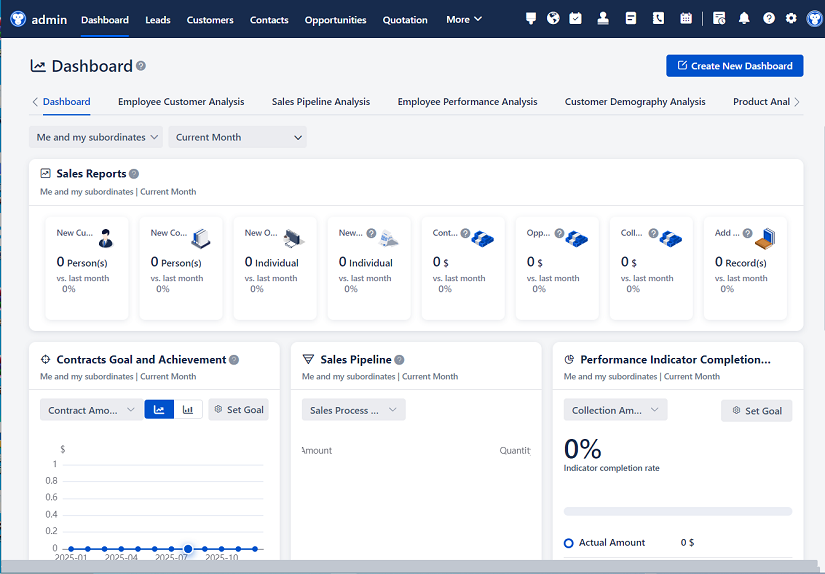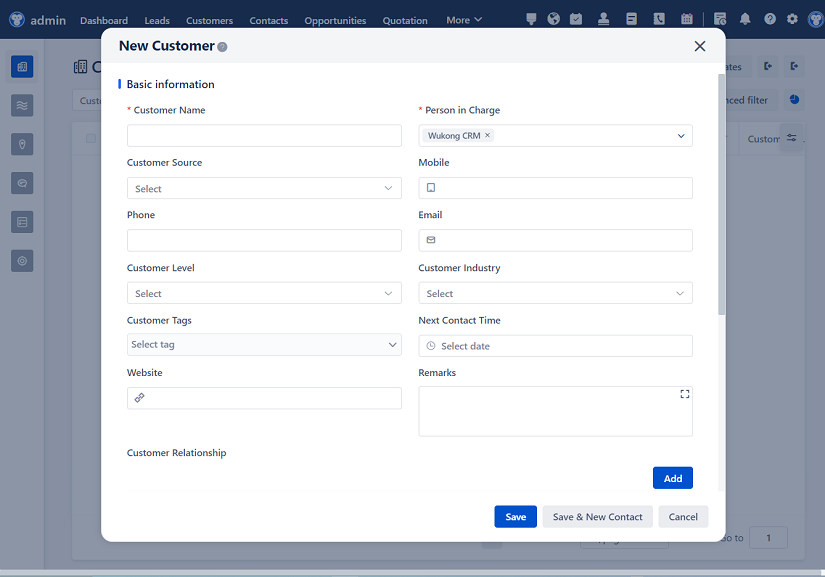
△Click on the top right corner to try Wukong CRM for free
You know, I’ve been thinking a lot lately about how messy customer orders can get in growing businesses—especially when you’re juggling multiple departments, time zones, and communication channels. It’s like trying to keep five balls in the air while riding a unicycle. That’s why I was genuinely excited when I first heard about this thing called the Order Full-process Tracking CRM Management System. Honestly, the name sounds a bit technical at first, but once you dive into it, you realize it’s kind of a game-changer.
Let me break it down for you. Imagine you have a customer who places an order—could be online, over the phone, or even through a sales rep. Without a solid system, that order might go into someone’s inbox, then get forwarded, maybe printed out, stuck on a whiteboard, or lost in a spreadsheet somewhere. Sound familiar? Yeah, we’ve all been there. But with this CRM system, the moment that order is placed, it gets logged automatically into a central platform. No more guessing where things are.
Free use of CRM system: Free CRM
And here’s the cool part—it doesn’t just store the order. It tracks it. Every single step. From the initial inquiry to payment confirmation, production, shipping, delivery, and even post-sale support. It’s like having a GPS tracker for your entire order lifecycle. You can literally see where everything stands in real time. No more calling around asking, “Hey, has the invoice been sent?” or “Is the product packed yet?” It’s all right there.
I remember talking to a client last month who runs a mid-sized e-commerce business. She told me she used to spend hours every day just chasing updates. Her team was overwhelmed, customers were getting frustrated with delayed responses, and mistakes—like wrong items shipped or missed discounts—were happening way too often. Then they implemented this full-process tracking CRM. Within three weeks, she said her team was breathing easier, response times dropped by 60%, and customer satisfaction scores went up. That’s not just a win—that’s a transformation.
What really impressed me is how intuitive the interface is. You don’t need to be a tech wizard to use it. The dashboard gives you a clear visual flow—kind of like a timeline or a Kanban board—showing each order moving through stages. You can click on any order and see every interaction: emails sent, calls made, notes from the warehouse, payment status, shipping carrier updates. It’s like having a digital diary for every customer journey.
And let’s talk about integration. One of my biggest concerns with new systems is whether they’ll play nice with what we already use. This one does. It connects seamlessly with popular email platforms, accounting software like QuickBooks, shipping carriers like FedEx and DHL, and even your existing website or e-commerce platform. So you’re not starting from scratch—you’re upgrading what you already have.
Another thing I love? Automation. I mean, who doesn’t want to save time on repetitive tasks? The system can auto-generate invoices, send follow-up emails, notify the warehouse when an order is ready for packing, and even trigger customer feedback surveys after delivery. It’s not replacing people—it’s freeing them up to focus on higher-value work, like building relationships or solving complex issues.

Now, I know what some of you might be thinking: “Sounds great, but isn’t it expensive?” Well, here’s the truth—I looked into the pricing, and honestly, it’s pretty reasonable for what you get. When you consider the cost of errors, lost orders, unhappy customers, and wasted employee hours, this system pays for itself pretty quickly. Plus, most providers offer scalable plans, so you only pay for what you need. Start small, grow as you go.
Security is another big deal, right? I mean, you’re dealing with customer data, payment info, internal notes—stuff you don’t want falling into the wrong hands. The good news is that these CRM systems usually come with enterprise-grade encryption, role-based access control, and regular backups. You can set permissions so that only certain people can view or edit sensitive information. It’s like having a digital lock on every file.

One feature that surprised me was the analytics dashboard. It doesn’t just track orders—it helps you understand them. You can generate reports on order volume by region, average processing time, top-selling products, customer retention rates, and even predict future demand based on trends. That kind of insight? That’s gold for making smarter business decisions.
I also appreciate how flexible it is across industries. Whether you’re in manufacturing, retail, logistics, or even service-based businesses like consulting or event planning, the core idea still applies: track every touchpoint, keep everyone informed, and deliver a better experience. I spoke with a guy who runs a custom furniture workshop—he uses the system to manage everything from design approvals to material sourcing to delivery scheduling. He said it cut his project completion time by nearly 30%.
Team collaboration gets way smoother too. Instead of relying on scattered emails or group chats, all communication related to an order stays within the system. If a customer asks a question, the sales rep logs it, the warehouse team sees the update, and the finance department gets notified when payment clears. Everyone’s on the same page—literally.
And for managers? It’s a dream. You can monitor team performance, spot bottlenecks (like orders piling up at the quality check stage), and reassign tasks if someone’s overloaded. It’s not about micromanaging—it’s about empowering your team with visibility and clarity.
Customer experience improves dramatically. Think about it: when your team knows exactly where an order is, they can give accurate updates. No more “I’ll have to check and get back to you.” You can say, “Your order was shipped this morning—here’s the tracking number.” That builds trust. And when issues do come up, you can address them faster because you see them early.
I should mention mobile access too. Most of these systems have apps for iOS and Android, so your team can check order statuses, update records, or respond to alerts from anywhere. Field reps, delivery drivers, remote workers—they’re all connected in real time. It’s perfect for today’s hybrid work environment.

Onboarding wasn’t as painful as I expected either. The vendors usually provide training sessions, video tutorials, and dedicated support. Some even assign a success manager to help you set everything up. And because the system is designed with user experience in mind, most employees pick it up quickly. One company told me their staff was fully operational within a week.
Of course, no system is perfect. There’s always a learning curve, and if your team resists change, adoption might take time. But from what I’ve seen, once people realize how much easier their jobs become, they warm up to it fast. It’s like switching from paper maps to GPS—once you’ve tried the better way, you don’t want to go back.
Another benefit? Scalability. If your business grows—say, you expand to new markets or launch new product lines—the system grows with you. You can add users, customize workflows, integrate new tools, and handle higher volumes without chaos. That peace of mind is priceless.
Let’s not forget about customer self-service. Many of these CRMs include client portals where customers can log in, view their order history, track shipments, download invoices, and even submit support tickets. It reduces the load on your team and gives customers more control—which they love.
Data consistency is another win. Before, you might have had customer info in one place, order details in another, and shipping notes scribbled on a notepad. Now, everything lives in one unified record. No duplicates, no contradictions, no confusion.
And when it comes to reporting to stakeholders or preparing for audits, pulling together accurate data takes minutes instead of days. You can export clean, professional reports with just a few clicks.
Honestly, I think the biggest impact is cultural. When everyone in the company—from sales to shipping—can see the full picture, it fosters accountability and alignment. People start thinking in terms of the entire customer journey, not just their little piece of it. That shift in mindset? That’s where real improvement happens.
So yeah, I’m a believer. The Order Full-process Tracking CRM Management System isn’t just software—it’s a way to bring order to complexity, reduce stress, and deliver better results for both your team and your customers. If you’re still managing orders with spreadsheets and sticky notes, I’d seriously encourage you to take a look. It might just be the upgrade your business needs.
FAQs (Frequently Asked Questions):
Q: Is this system only for large companies?
A: Not at all! While big companies benefit, small and medium-sized businesses often see the biggest improvements because they’re usually the ones drowning in manual processes.
Q: Can I customize the workflow to match my business process?
Absolutely. Most systems let you tailor stages, approval steps, notifications, and fields to fit exactly how your team works.
Q: What if I have existing customer data in another system?
No problem. These CRMs usually support data migration tools or services to import your contacts, orders, and history smoothly.
Q: Do I need IT support to set it up?
Not necessarily. Many providers design their systems to be user-friendly, with guided setup and customer support to walk you through it.
Q: Can customers see their order status in real time?
Yes! With a customer portal or automated status updates via email/SMS, transparency becomes effortless.

Q: How secure is my data in the cloud?
Top-tier CRM systems use advanced security measures like SSL encryption, two-factor authentication, and regular compliance audits to protect your data.
Q: Will this replace my current CRM or ERP?
It can complement or replace them, depending on your needs. Many businesses use it to enhance their existing tools rather than ditch them entirely.
Q: Can I try it before committing?
Most vendors offer free trials or demos—definitely take advantage of those to see how it feels for your team.
Related links:
Free trial of CRM
Understand CRM software

△Click on the top right corner to try Wukong CRM for free